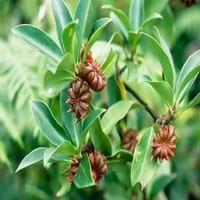Life Span
Perennial
Perennial
Type
Shrub
Broadleaf Evergreen
Origin
Eastern Asia, Japan
Southeastern United States
Types
Not Available
Not Available
Habitat
Old fields, stream banks
Dappled Shade, Sunny Edge, Woodlands
USDA Hardiness Zone
4-8
6-9
AHS Heat Zone
8-5
Not Available
Sunset Zone
A3, 2b, 3a, 3b, 4, 5, 6, 7, 8, 9, 10, 11, 12, 13, 14, 15, 16, 17, 18, 19, 20, 21, 22, 23, 24
21,22
Habit
Oval or Rounded
Upright/Erect
Flower Color
Yellow, Yellow green
Yellow green
Flower Color Modifier
Not Available
Bicolor
Fruit Color
Red orange
Green, Brown
Leaf Color in Spring
Light Green
Olive
Leaf Color in Summer
Green
Olive
Leaf Color in Fall
Purple, Orange, Burgundy, Crimson
Olive
Leaf Color in Winter
Not Available
Olive
Leaf Shape
Obovate
Long, Alternate
Plant Season
Spring, Summer, Fall, Winter
Spring, Summer, Fall, Winter
Sunlight
Full Sun, Partial Sun
Full Sun, Partial Sun, Partial shade
Type of Soil
Clay, Loam, Sand
Clay, Loam, Sand
The pH of Soil
Acidic, Neutral, Alkaline
Acidic, Neutral
Soil Drainage
Average
Average
Bloom Time
Spring, Late Spring
Late Spring, Early Summer
Tolerances
Pollution, Drought, Salt, Soil Compaction
Not Available
Where to Plant?
Ground, Pot
Ground
How to Plant?
Seedlings
Seedlings
Plant Maintenance
Medium
Medium
Watering Requirements
Requires regular watering during dry weather
Average Water Needs, Do Not over Water
In Summer
Lots of watering
Lots of watering
In Spring
Moderate
Moderate
In Winter
Average Water
Average Water
Soil pH
Acidic, Neutral, Alkaline
Acidic, Neutral
Soil Type
Clay, Loam, Sand
Clay, Loam, Sand
Soil Drainage Capacity
Average
Average
Sun Exposure
Full Sun, Partial Sun
Full Sun, Partial Sun, Partial shade
Pruning
Remove damaged leaves, Remove dead branches, Remove dead leaves
Remove damaged leaves, Remove dead branches, Remove dead leaves
Fertilizers
All-Purpose Liquid Fertilizer
Compost
Pests and Diseases
Red blotch, Sunken patches
Fungal Diseases
Plant Tolerance
Drought
Drought
Flowers
Insignificant
Insignificant
Flower Petal Number
Single
Single
Foliage Texture
Medium
Coarse
Foliage Sheen
Matte
Glossy
Allergy
Not Available
Hypertonia, Nausea, Spasms, Vomiting
Aesthetic Uses
Borders
Beautification, Borders
Beauty Benefits
Not Available
Good for skin
Environmental Uses
Air purification
Erosion control
Medicinal Uses
Anthelmintic, Antibacterial, Antiseptic, Cancer
Antibacterial, Appetizer, Expectorant, Homeopathy
Part of Plant Used
Fruits, Leaves
Fruits
Other Uses
Used to make yellow dye
Used as essential oil, Used in flavouring curries, teas, Used to sweeten the breath
Used As Indoor Plant
No
No
Used As Outdoor Plant
Yes
Yes
Garden Design
Edging, Foundation, Hedges, Mixed Border, Rock Garden, Wall
Hedges, Mixed Border, Screening, Wind Break, Tropical, Wildflower
Botanical Name
BERBERIS thunbergii
ILLICIUM parviflorum
Common Name
Japanese Barberry
Chinese Star Anise, Badiam
In Hindi
Japanese Barberry
चक्र फूल
In German
Thunberg-Berberitze
Sternanis
In French
Berberis thunbergii
Anis étoilé
In Spanish
Berberis thunbergii
Anís estrellado
In Greek
Japanese Barberry
Γλυκάνισο
In Portuguese
Japanese Barberry
Star Anise
In Polish
Berberys Thunberga
Anyż
In Latin
Japanese Barberry
Star Anise
Phylum
Magnoliophyta
Magnoliophyta
Class
Magnoliopsida
Magnoliopsida
Order
Ranunculales
Illiciales
Family
Berberidaceae
Illiciaceae
Clade
Angiosperms, Eudicots
Angiosperms
Tribe
Not Available
Illicieae
Subfamily
Not Available
Illicioideae
Number of Species
Not Available
Not Available
Season and Care of Japanese Barberry and Star Anise
Season and care of Japanese Barberry and Star Anise is important to know. While considering everything about Japanese Barberry and Star Anise Care, growing season is an essential factor. Japanese Barberry season is Spring, Summer, Fall and Winter and Star Anise season is Spring, Summer, Fall and Winter. The type of soil for Japanese Barberry is Clay, Loam, Sand and for Star Anise is Clay, Loam, Sand while the PH of soil for Japanese Barberry is Acidic, Neutral, Alkaline and for Star Anise is Acidic, Neutral.
Japanese Barberry and Star Anise Physical Information
Japanese Barberry and Star Anise physical information is very important for comparison. Japanese Barberry height is 90.00 cm and width 120.00 cm whereas Star Anise height is 180.00 cm and width 150.00 cm. The color specification of Japanese Barberry and Star Anise are as follows:
Japanese Barberry flower color: Yellow and Yellow green
Japanese Barberry leaf color: Light Green
Star Anise flower color: Yellow green
- Star Anise leaf color: Olive
Care of Japanese Barberry and Star Anise
Care of Japanese Barberry and Star Anise include pruning, fertilizers, watering etc. Japanese Barberry pruning is done Remove damaged leaves, Remove dead branches and Remove dead leaves and Star Anise pruning is done Remove damaged leaves, Remove dead branches and Remove dead leaves. In summer Japanese Barberry needs Lots of watering and in winter, it needs Average Water. Whereas, in summer Star Anise needs Lots of watering and in winter, it needs Average Water.





